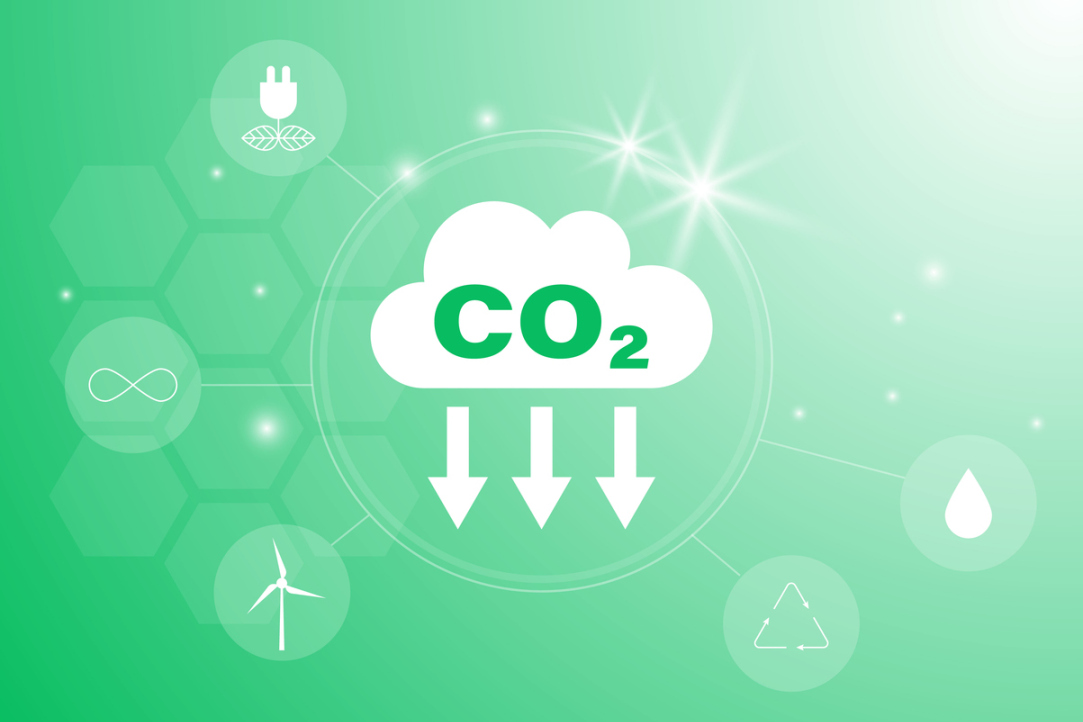HSE Scientists Discover Method to Convert CO₂ into Fuel Without Expensive Reagents

Researchers at HSE MIEM, in collaboration with Chinese scientists, have developed a catalyst that efficiently converts CO₂ into formic acid. Thanks to carbon coating, it remains stable in acidic environments and functions with minimal potassium, contrary to previous beliefs that high concentrations were necessary. This could lower the cost of CO₂ processing and simplify its industrial application—eg in producing fuel for environmentally friendly transportation. The study has been published in Nature Communications.
The electrochemical reduction of carbon dioxide is a process in which CO₂ is converted into other chemical compounds through the application of an electric current. It has long been regarded not only as a method for recycling CO₂, but also as a source of valuable raw materials such as formic acid, which can serve as a liquid fuel, solvent, or chemical industry feedstock.
However, a major challenge in the electrochemical reduction of CO₂ is the occurrence of a side reaction that produces hydrogen, thereby reducing the overall efficiency of the process. In alkaline solutions, this issue is typically addressed by adding more potassium ions (K⁺); however, this not only increases the cost of the process but also leads to precipitation, which clogs the system and hinders its operation. Conversely, in an acidic environment, catalysts degrade rapidly and lose their effectiveness.
A team of researchers, including those from HSE University, has proposed an alternative approach. They developed a catalyst that remains stable in acidic environments while requiring only a minimal amount of potassium. The catalyst is made from indium oxide (In₂O₃) and coated with a thin layer of carbon.
First, through computer modelling, the researchers at HSE MIEM determined how to control the distribution of ions on the catalyst's surface. The model revealed that the carbon coating not only protects the catalyst from degradation but also creates an electric field that holds potassium ions on its surface. As a result, potassium does not precipitate, and undesirable side effects are minimised.
To test the model's predictions, Chinese scientists synthesised indium oxide nanoparticles and encapsulated them in a thin layer of carbon. The team then conducted a series of experiments in an electrolyte reactor, using a highly acidic environment and a fraction of the potassium typically used in conventional systems. The tests showed that even under these conditions, the catalyst remained stable, maintaining activity for over 100 hours, with a CO₂ to formic acid conversion efficiency of 98.9%.

'We have demonstrated that it is possible to eliminate excess potassium hindering the system's operation. This approach not only reduces the cost of the process but also improves catalyst stability,' explains Dongyu Liu, Assistant Professor at HSE MIEM.
To verify that the carbon coating is the key factor, the researchers conducted additional tests. They found that without the coating, indium oxide rapidly reduces to metallic indium, which is far less effective at facilitating the electrochemical reduction of CO₂. This confirms that the carbon layer protects the catalyst, preventing its degradation.
This method not only simplifies CO₂ processing technology but also makes it more accessible for industrial applications. Unlike conventional alkaline systems, it does not require a high concentration of potassium and prevents precipitation. The implementation of this technology in real-world systems could make carbon dioxide recycling more environmentally sustainable.
'We have made the process more stable and scalable, bringing the electrochemical reduction of carbon dioxide closer to real-world industrial applications,' says Andrey Vasenko, Professor at HSE MIEM. 'This technology can be useful not only for synthesising formic acid but also for other processes related to carbon dioxide conversion.'
See also:
Larger Groups of Students Use AI More Effectively in Learning
Researchers at the Institute of Education and the Faculty of Economic Sciences at HSE University have studied what factors determine the success of student group projects when they are completed with the help of artificial intelligence (AI). Their findings suggest that, in addition to the knowledge level of the team members, the size of the group also plays a significant role—the larger it is, the more efficient the process becomes. The study was published in Innovations in Education and Teaching International.
New Models for Studying Diseases: From Petri Dishes to Organs-on-a-Chip
Biologists from HSE University, in collaboration with researchers from the Kulakov National Medical Research Centre for Obstetrics, Gynecology, and Perinatology, have used advanced microfluidic technologies to study preeclampsia—one of the most dangerous pregnancy complications, posing serious risks to the life and health of both mother and child. In a paper published in BioChip Journal, the researchers review modern cellular models—including advanced placenta-on-a-chip technologies—that offer deeper insights into the mechanisms of the disorder and support the development of effective treatments.
Using Two Cryptocurrencies Enhances Volatility Forecasting
Researchers from the HSE Faculty of Economic Sciences have found that Bitcoin price volatility can be effectively predicted using Ethereum, the second-most popular cryptocurrency. Incorporating Ethereum into a predictive model reduces the forecast error to 23%, outperforming neural networks and other complex algorithms. The article has been published in Applied Econometrics.
Administrative Staff Are Crucial to University Efficiency—But Only in Teaching-Oriented Institutions
An international team of researchers, including scholars from HSE University, has analysed how the number of non-academic staff affects a university’s performance. The study found that the outcome depends on the institution’s profile: in research universities, the share of administrative and support staff has no effect on efficiency, whereas in teaching-oriented universities, there is a positive correlation. The findings have been published in Applied Economics.
Physicists at HSE University Reveal How Vortices Behave in Two-Dimensional Turbulence
Researchers from the Landau Institute for Theoretical Physics of the Russian Academy of Sciences and the HSE University's Faculty of Physics have discovered how external forces affect the behaviour of turbulent flows. The scientists showed that even a small external torque can stabilise the system and extend the lifetime of large vortices. These findings may improve the accuracy of models of atmospheric and oceanic circulation. The paper has been published in Physics of Fluids.
Solvent Instead of Toxic Reagents: Chemists Develop Environmentally Friendly Method for Synthesising Aniline Derivatives
An international team of researchers, including chemists from HSE University and the A.N. Nesmeyanov Institute of Organoelement Compounds of the Russian Academy of Sciences (INEOS RAS), has developed a new method for synthesising aniline derivatives—compounds widely used in the production of medicines, dyes, and electronic materials. Instead of relying on toxic and expensive reagents, they proposed using tetrahydrofuran, which can be derived from renewable raw materials. The reaction was carried out in the presence of readily available cobalt salts and syngas. This approach reduces hazardous waste and simplifies the production process, making it more environmentally friendly. The study has been published in ChemSusChem.
How Colour Affects Pricing: Why Art Collectors Pay More for Blue
Economists from HSE University, St Petersburg State University, and the University of Florida have found which colours in abstract paintings increase their market value. An analysis of thousands of canvases sold at auctions revealed that buyers place a higher value on blue and favour bright, saturated palettes, while showing less appreciation for traditional colour schemes. The article has been published in Information Systems Frontiers.
New Method for Describing Graphene Simplifies Analysis of Nanomaterials
An international team, including scientists from HSE University, has proposed a new mathematical method to analyse the structure of graphene. The scientists demonstrated that the characteristics of a graphene lattice can be represented using a three-step random walk model of a particle. This approach allows the lattice to be described more quickly and without cumbersome calculations. The study has been published in Journal of Physics A: Mathematical and Theoretical.
Scientists Have Modelled Supercapacitor Operation at Molecular and Ionic Level
HSE scientists used supercomputer simulations to study the behaviour of ions and water molecules inside the nanopores of a supercapacitor. The results showed that even a very small amount of water alters the charge distribution inside the nanopores and influences the device’s energy storage capacity. This approach makes it possible to predict how supercapacitors behave under different electrolyte compositions and humidity conditions. The paper has been published in Electrochimica Acta. The study was supported by a grant from the Russian Science Foundation (RSF).
Designing an Accurate Reading Skills Test: Why Parallel Texts are Important in Dyslexia Diagnosis
Researchers from the HSE Centre for Language and Brain have developed a tool for accurately assessing reading skills in adults with reading impairments. It can be used, for instance, before and after sessions with a language therapist. The tool includes two texts that differ in content but are equal in complexity: participants were observed to read them at the same speed, make a similar number of errors, and understand the content to the same degree. Such parallel texts will enable more accurate diagnosis of dyslexia and better monitoring of the effectiveness of interventions aimed at addressing it. The paper has been published in Educational Studies.




